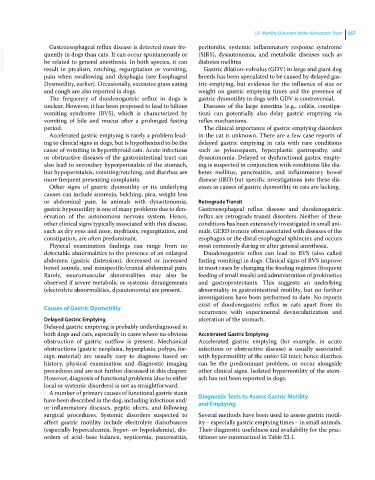Page 599 - Clinical Small Animal Internal Medicine
P. 599
53 Motility Disorders of the Alimentary Tract 567
Gastroesophageal reflux disease is detected more fre- peritonitis, systemic inflammatory response syndrome
VetBooks.ir quently in dogs than cats. It can occur spontaneously or (SIRS), dysautonomia, and metabolic diseases such as
be related to general anesthesia. In both species, it can
diabetes mellitus
result in ptyalism, retching, regurgitation or vomiting,
Gastric dilation‐volvulus (GDV) in large and giant dog
pain when swallowing and dysphagia (see Esophageal breeds has been speculated to be caused by delayed gas-
Dysmotility, earlier). Occasionally, excessive grass eating tric emptying, but evidence for the influence of size or
and cough are also reported in dogs. weight on gastric emptying times and the presence of
The frequency of duodenogastric reflux in dogs is gastric dysmotility in dogs with GDV is controversial.
unclear. However, it has been proposed to lead to bilious Diseases of the large intestine (e.g., colitis, constipa-
vomiting syndrome (BVS), which is characterized by tion) can potentially also delay gastric emptying via
vomiting of bile and mucus after a prolonged fasting reflex mechanisms.
period. The clinical importance of gastric emptying disorders
Accelerated gastric emptying is rarely a problem lead- in the cat is unknown. There are a few case reports of
ing to clinical signs in dogs, but is hypothesized to be the delayed gastric emptying in cats with rare conditions
cause of vomiting in hyperthyroid cats. Acute infectious such as pylorospasm, hyperplastic gastropathy, and
or obstructive diseases of the gastrointestinal tract can dysautonomia. Delayed or dysfunctional gastric empty-
also lead to secondary hyperperistalsis of the stomach, ing is suspected in conjunction with conditions like dia-
but hypoperistalsis, vomiting/retching, and diarrhea are betes mellitus, pancreatitis, and inflammatory bowel
more frequent presenting complaints. disease (IBD) but specific investigations into these dis-
Other signs of gastric dysmotility or its underlying eases as causes of gastric dysmotility in cats are lacking.
causes can include anorexia, belching, pica, weight loss
or abdominal pain. In animals with dysautonomia, Retrograde Transit
gastric hypomotility is one of many problems due to den- Gastroesophageal reflux disease and duodenogastric
ervation of the autonomous nervous system. Hence, reflux are retrograde transit disorders. Neither of these
other clinical signs typically associated with this disease, conditions has been extensively investigated in small ani-
such as dry eyes and nose, mydriasis, regurgitation, and mals. GERD is more often associated with diseases of the
constipation, are often predominant. esophagus or the distal esophageal sphincter, and occurs
Physical examination findings can range from no most commonly during or after general anesthesia.
detectable abnormalities to the presence of an enlarged Duodenogastric reflux can lead to BVS (also called
abdomen (gastric distension), decreased or increased fasting vomiting) in dogs. Clinical signs of BVS improve
bowel sounds, and nonspecific/cranial abdominal pain. in most cases by changing the feeding regimen (frequent
Rarely, neuromuscular abnormalities may also be feeding of small meals) and administration of prokinetics
observed if severe metabolic or systemic derangements and gastroprotectants. This suggests an underlying
(electrolyte abnormalities, dysautonomia) are present. abnormality in gastrointestinal motility, but no further
investigations have been performed to date. No reports
exist of duodenogastric reflux in cats apart from its
Causes of Gastric Dysmotility
occurrence with experimental devascularization and
Delayed Gastric Emptying ulceration of the stomach.
Delayed gastric emptying is probably underdiagnosed in
both dogs and cats, especially in cases where no obvious Accelerated Gastric Emptying
obstruction of gastric outflow is present. Mechanical Accelerated gastric emptying (for example, in acute
obstructions (gastric neoplasia, hyperplasia, polyps, for- infectious or obstructive disease) is usually associated
eign material) are usually easy to diagnose based on with hypermotility of the entire GI tract; hence diarrhea
history, physical examination and diagnostic imaging can be the predominant problem, or occur alongside
procedures and are not further discussed in this chapter. other clinical signs. Isolated hypermotility of the stom-
However, diagnosis of functional problems (due to either ach has not been reported in dogs.
local or systemic disorders) is not as straightforward.
A number of primary causes of functional gastric stasis
have been described in the dog, including infectious and/ Diagnostic Tests to Assess Gastric Motility
and Emptying
or inflammatory diseases, peptic ulcers, and following
surgical procedures. Systemic disorders suspected to Several methods have been used to assess gastric motil-
affect gastric motility include electrolyte disturbances ity – especially gastric emptying times – in small animals.
(especially hypercalcemia, hyper‐ or hypokalemia), dis- Their diagnostic usefulness and availability for the prac-
orders of acid–base balance, septicemia, pancreatitis, titioner are summarized in Table 53.1.

